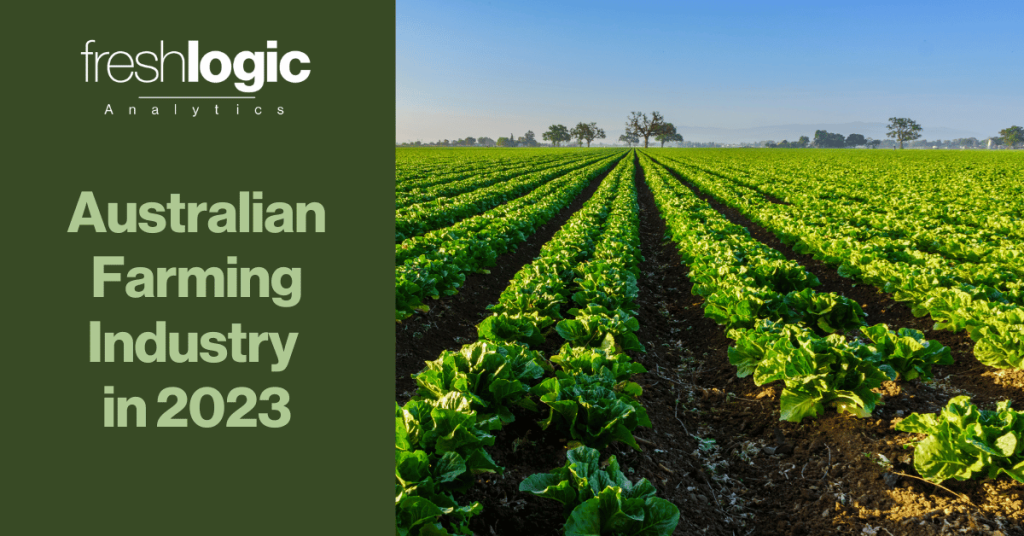The Australian farming industry is a cornerstone of the nation’s economy and plays a crucial role in supplying food and raw materials domestically and to international markets. With its diverse geography and climate, Australia supports a wide range of agricultural activities, making it a significant player in the global farming landscape.
Freshlogic‘s data analysts and market researchers are uniquely positioned to be at the forefront of all horticulture industry trends, consumer trends and retailer trends across the fresh produce and food service sectors.
Whilst we usually provide more succinct data such as our FreshIncites, in this article, we will delve into broader topics and various aspects of the Australian farming industry, exploring its history, current state, challenges, and future prospects.

The article is broken down into the following sections:
Table of Contents
Overview of the Australian Farming Industry
The Australian farming industry stands as a cornerstone of the nation’s economy and cultural identity. It encompasses a vast array of agricultural activities that produce food, fiber, and raw materials to meet both domestic and international demand. Horticulture in Australia has a rich history shaped by innovation, adaptation, and geographic diversity, the industry plays a pivotal role in shaping rural landscapes, fostering economic growth, and contributing to global food security.
In this overview, we will delve into the key facets of the Australian farming industry, highlighting its significance, challenges, and future prospects.
Key States and Commodities
While agriculture thrives across the country, several key states play a particularly significant role in the industry’s growth. New South Wales (NSW), Queensland (QLD), and Victoria (VIC) are renowned for their substantial contributions to Australian agriculture.
- New South Wales Agriculture: This state boasts a wide range of agricultural activities, including grain and cereal crops, livestock production, horticulture, and viticulture. The Hunter Valley, for instance, is known for its wine production, while the Riverina region is a hub for rice cultivation and sheep farming.
- Queensland Agriculture: Queensland’s warm climate makes it a fertile ground for tropical fruits, sugarcane, and beef production. It is a major contributor to Australia’s beef exports, and regions like the Lockyer Valley are renowned for their vegetable and fruit production.
- Victorian Agriculture: Known for its fertile soil and diverse agricultural output, Victoria excels in dairy farming, viticulture, and horticulture. The state’s cool climate is ideal for producing high-quality wine and a range of vegetables and fruits such as stonefruit.
- Western Australian Agriculture: Horticulture production in WA was valued at $909 million in 2015/16, with an export value of $119 million. The sector is experiencing strong growth which is driven by the demand from Asia and beyond, for healthy, safe and clean produce.
Australian agriculture accounts for:
- 55% of Australian land use (427 million hectares, excluding timber production, in December 2020) and
- 24% of water extractions (2,809 gigalitres used by agriculture in 2020–21);
- 11.6% of goods and services exports in 2021–22;
- 2.4% of value added (GDP) and 2.5% of employment in 2021–22.
Source: Australian Department of Agriculture, Fisheries and Forestry
History of Farming in Australia
The history of farming in Australia is a tale of adaptation and innovation. Indigenous Australians practiced various forms of agriculture, including the use of fire to manage landscapes and encourage plant growth. However, the arrival of European settlers in the late 18th century brought about significant changes. Traditional farming practices from Europe were adapted to suit the Australian environment, leading to the establishment of the first farms.
Throughout the 19th century, agriculture in Australia evolved rapidly. As transportation improved, farms spread across various regions, leading to the growth of agriculture in states like New South Wales, Queensland, and Victoria. Sheep farming dominated the early years, with wool becoming a major export.
In the late 19th and early 20th centuries, advancements in irrigation and machinery allowed for more diverse crops and agricultural practices.
Common Terminology in Farming Sectors
The farming industry, like any other, has its unique terminology that can be perplexing to outsiders. Understanding this terminology is essential for effective communication and collaboration within the industry. Terms such as “crop rotation,” “irrigation,” “pesticide,” “agriTech” and “agriBusiness” are just a few examples of words that are commonly used in farming discussions.
These terms encapsulate essential concepts that drive the industry’s operations.
Types of Australian Farmers
The Australian farming landscape encompasses various types of farmers, each specialising in different commodities and practices. These include crop farmers, livestock farmers, dairy farmers, and horticulturists, among others. The diversity of climates across different states has led to specialisation in specific products in different regions.
Exploring the Difference between Growers and Farmers
Within the farming industry, the terms “growers” and “farmers” are often used interchangeably, but they can have nuanced distinctions. Growers typically refer to those who specialise in cultivating crops, such as fruits, vegetables, and grains.
Farmers, on the other hand, engage in broader agricultural activities that might include livestock rearing, dairy production, and other forms of agribusiness. Both growers and farmers contribute significantly to Australia’s agricultural output, playing crucial roles in the country’s food supply chain.
Impacts of Weather on Australian Farming
Australia’s farming industry is acutely sensitive to the country’s diverse and often unpredictable weather patterns. Extreme weather events, such as droughts, floods, heatwaves, and bushfires, can have devastating effects on agricultural production. The interplay between climate variability and farming operations underscores the industry’s vulnerability to the changing climate. In this section, we will explore the profound impacts of weather events on Australian farming, highlighting specific examples of significant events that have disrupted crop yields and livelihoods.
Drought: The Silent Menace
Droughts are among the most significant challenges faced by Australian farmers. Prolonged periods of reduced rainfall can lead to soil moisture deficits, decreased water availability, and reduced crop yields. In New South Wales, for instance, drought conditions have a significant impact on cereal and oilseed production. Freshlogic’s farming data insights show, prolonged droughts have caused grain yields to plummet, resulting in reduced income for farmers and increased reliance on government assistance.
The Black Summer: Bushfires and Agricultural Losses
The summer of 2019/2020 marked a devastating period in Australia’s history, known as the “Black Summer.”
Widespread bushfires swept across all major states with Tasmania and ACT receiving the smallest impact. These fires not only claimed human lives and destroyed homes but also wreaked havoc on agricultural landscapes. Vineyards in regions like Victoria’s Yarra Valley were hit hard, with smoke taint affecting wine quality. The unprecedented scale of the bushfires highlighted the urgent need for climate resilience and fire mitigation strategies within the Australian farming industry.
Floods: A Double-Edged Sword for the Australian Farming Industry
While droughts can devastate crops, excessive rainfall and flooding present their own set of challenges. Heavy rainfall events can lead to soil erosion, waterlogging, and crop damage. Queensland, known for its agriculture-rich landscape, has experienced numerous flood events that disrupt farming operations.
Freshlogic’s farming statistics reveal that floods have led to substantial crop losses in areas where water has inundated fields, destroying crops and damaging infrastructure.
Heatwaves and Crop Stress
Rising temperatures and heatwaves pose a significant threat to crop health and productivity. Heat stress can reduce yields, affect fruit set, and lead to poor grain filling. In farming regions like the Murray-Darling Basin, where irrigated agriculture is vital, heatwaves can increase water demand and pressure on water resources. Freshlogic’s farming research highlights the need for adaptive practices, such as planting heat-tolerant crop varieties and optimising irrigation strategies, to mitigate the impact of rising temperatures on crop production.
Hailstorms and Unpredictable Damage
Hailstorms are a frequent weather phenomenon in parts of Australia, causing unpredictable and often severe damage to crops. In horticultural regions like South Australia’s Riverland, hailstorms can decimate orchards and vineyards, leading to financial losses for farmers and affecting the supply of fresh produce. These events underscore the vulnerability of farming operations to sudden weather changes and emphasise the importance of crop insurance and protective measures.
Climate Resilience and Adaptation
In the face of these challenges, Australian farmers are actively seeking strategies to enhance climate resilience and adaptability. Freshlogic’s farming data insights indicate a growing emphasis on diversification, sustainable land management, and the adoption of technology-driven solutions. From implementing precision irrigation systems to investing in weather-resistant crop varieties, farmers are proactively working to minimize the impact of weather events on their operations.
Government Support and Disaster Relief
Government agencies and industry bodies play a critical role in providing support and disaster relief to farmers affected by weather events. Programs such as the Farm Household Allowance and disaster recovery funding aim to assist farmers during times of crisis. Collaborations between agricultural organizations, government agencies, and research institutions are essential for developing strategies that enhance climate resilience and reduce the industry’s vulnerability to extreme weather events.
Consumer Trends and Food Consumption Habits
Global Food Consumption Habits and Their Effects on the Australian Farming Industry
The global food consumption landscape has a profound impact on the Australian Farming Industry. As international demand for certain products rises, Australian farmers must adapt to meet these changing preferences. For example, the increasing demand for organic and sustainably produced foods has driven shifts in farming practices across the country. Data insights from Freshlogic highlight the need for Australian farmers to stay attuned to global trends and consumer preferences to remain competitive in the international market.
Consumer Habits in Fruit and Vegetable Consumption
Australian Farming Industry: A Focus on Freshness and Health
- Preference for Fresh Produce: In Australia, there is a strong emphasis on consuming fresh fruits and vegetables. According to the Australian Bureau of Statistics (ABS), fresh fruit and vegetable consumption accounted for approximately 37% of the total daily vegetable intake among Australians in 2019.
- Growing Interest in Organic: The interest in organic produce is growing among Australian consumers. The Australian Organic Market Report revealed that the organic fruit and vegetable market experienced a 12.7% growth in 2020.
- Shift toward Plant-Based Diets: The trend of plant-based eating is gaining momentum in Australia. Roy Morgan research indicates that the number of Australians identifying as vegetarians has risen to 2.5 million in recent years.
- Convenience and Pre-Packaged Options: Convenience plays a role in consumption habits. A Nielsen report highlights that pre-packaged fresh produce has gained popularity among Australian consumers, catering to busy lifestyles.
- Rising Interest in Exotic Varieties: Australians are increasingly exploring exotic fruits and vegetables. Freshlogic partnered with leading fresh produce industry body Hort Innovation, to develop the Australian Horticulture Statistics Handbook. In the handbook we revealed an increase in the production and consumption of exotic fruits like avocados and mangoes.
Farming Operations
As of 2023, the Australian farming industry continues to thrive, thanks to a combination of technological advancements, innovative practices, and favourable market conditions. States like New South Wales, Queensland, and Victoria remain key contributors to the country’s agricultural output.
Farming Technology Revolution
Future Technology
The integration of technology into the farming industry is transforming traditional practices and driving efficiency gains. Automation, precision agriculture, and data analytics are reshaping how the Australian farming industry operates. Farmers and growers are adopting cutting-edge technologies to monitor soil health, optimise irrigation, and improve crop yields. Freshlogic’s market statistics underline the growing role of technology in the industry, with investments in research and development paving the way for a more sustainable and productive future.
Data Driven Decision Making
With growers and farmers needing to be more savvy than ever, many are turning to Australian Farming Industry data analytics and market research to fuel their crop planning. So too are retailers, relying heavily on up to date horticulture statistics to inform their category planning.
AgTech Advancements
The convergence of agriculture and technology, often referred to as “agritech,” is transforming the Australian farming industry. Innovations such as autonomous tractors, precision mapping, and data analytics are enhancing productivity and resource management. Many growers are utilising real-time data insights to optimise planting, irrigation, and harvesting. Freshlogic’s category reports and dashboards highlight the growing adoption of agritech solutions, signaling a new era of efficiency and sustainability in the Australian farming industry.
Farm Labour and Labour Shortages
Access to skilled labour is a significant concern in the Australian farming industry. Seasonal labour demands for planting and harvesting can strain the availability of workers. In states like Queensland, where horticulture is a major industry, addressing labour shortages is crucial for maintaining productivity. The industry is exploring ways to attract and retain workers, including innovative labour-sharing arrangements and technology-driven solutions.
Freshlogic’s farming data insights shed light on the evolving strategies for managing labour challenges in the sector.
Farming Challenges and Resilience
Climate Change and Farming
While the Australian farming industry has come a long way, it faces numerous challenges that threaten its sustainability and growth. One of the most pressing issues is the impact of climate change. Australia’s variable climate, characterised by droughts, floods, and heatwaves, poses a significant risk to agricultural productivity. Freshlogic’s market analytics indicates that growers are experiencing shifts in weather patterns that can lead to crop failures and increased production costs.
To mitigate these challenges, farmers are turning to innovative practices and technologies. Drought-resistant crop varieties, water-efficient irrigation systems, and sustainable farming methods are being embraced to ensure long-term productivity. Freshlogic’s extensive research in these areas underscore the increasing investment in research and development aimed at developing climate-resilient farming solutions.
Sustainable Practices and Environmental Stewardship
With growing concerns about environmental sustainability, Australian farmers are under increasing pressure to adopt practices that minimise their impact on the environment. Sustainable agriculture encompasses techniques that conserve water, reduce chemical usage, and protect biodiversity. In states like Victoria, where vineyards are prevalent, sustainable viticulture practices are becoming increasingly important. Freshlogic’s food industry insights show that consumers are placing a premium on products produced through environmentally responsible practices, prompting growers to incorporate sustainability into their operations.
Indigenous Land Management and Agriculture
Recognising the deep connection between Indigenous Australians and the land, there is a growing movement to integrate traditional Indigenous land management practices into modern agricultural systems. Indigenous knowledge about land, water, and resource management can offer valuable insights for sustainable farming practices.
By partnering with Indigenous communities, Australian farmers are tapping into a wealth of traditional wisdom that can enhance the resilience and productivity of their operations.
The Role of Government Policies
Government policies play a crucial role in shaping the direction of the Australian farming industry. Policies related to land use, water management, and trade agreements can significantly impact growers and farmers’ livelihoods. In recent years, there has been a push for policies that support sustainable agriculture, provide drought relief, and promote innovation in farming practices. Collaborations between government bodies and agricultural organisations are essential to addressing the industry’s challenges and unlocking its potential.
Hort Innovation have long been championing government reform and support of the horticulture sector Australia wide.
Future Trends and Opportunities
The future of the Australian farming industry is shaped by ongoing technological advancements, changing consumer preferences, and global market dynamics. Precision agriculture, smart farming practices, and sustainable production methods are expected to become increasingly integral to the industry’s growth. As the world grapples with food security concerns and climate change, Australian farmers are poised to play a vital role in meeting global challenges through innovative and adaptable practices.
Conclusion
The Australian farming industry, with its rich history, diverse landscapes, and forward-looking approach, stands as a critical pillar of the nation’s economy. Freshlogic’s role as a leading data insights provider underscores the importance of data-driven decision-making in navigating the industry’s complexities. As farmers and growers Australia wide continue to adapt to evolving challenges, their commitment to innovation, sustainability, and resilience will ensure that the Australian farming industry remains a formidable force in global agriculture and horticulture for generations to come.
About Freshlogic
Freshlogic are an Australian based market research company specialising in fresh produce insights and market data, agriculture and horticulture industry insights along with retailer and consumer analytics. We provide a series of market analytics across a range of products suitable for the food service industry and those looking to invest in businesses within the fresh produce industry. At Freshlogic we know that:
Your Business Decisions Need Strong Foundations
No matter the scale of decision, if it is fueled by data it is trusted. This ensures outcome dynamics are anticipated and understood. Freshlogic provides the foundational data you need to make critical operational and financial decisions when you need them.
Fresh Produce Insights Need to be Robust and Relevant
There is an inherent risk in basing decisions on dated, biased or flawed data / insights. Well formulated and up-to-date insights are critical to success. Utilising data from old reports or dated research methodologies can leave you open to risk. Our fresh produce data is always being updated with the latest industry metrics.
Data Needs to be Decision-Ready
Why go through the process of a traditional RFQ for a custom research projects or employ your own inhouse analyst? We have decision-ready fresh produce industry insights on demand, in a simple and easy to use dashboard.

